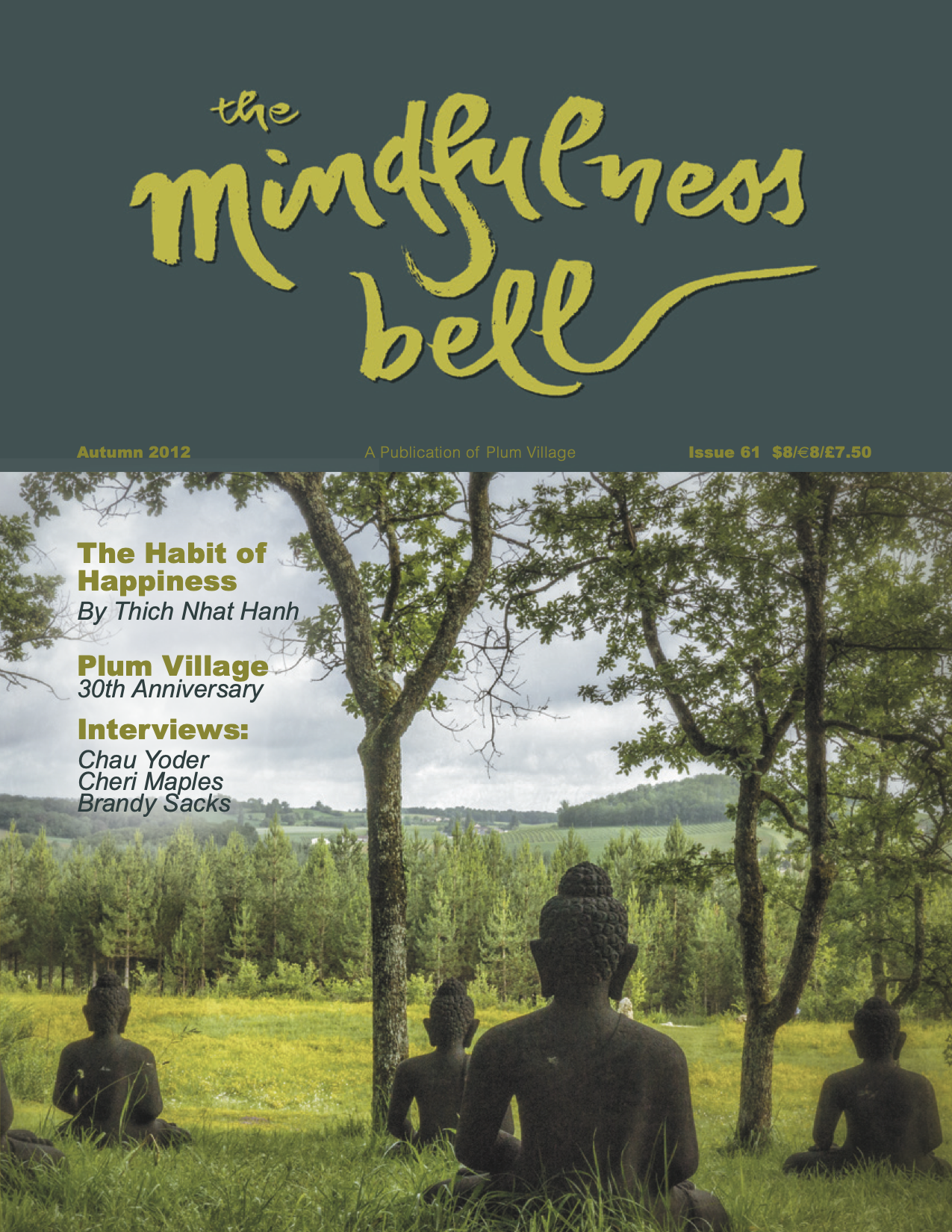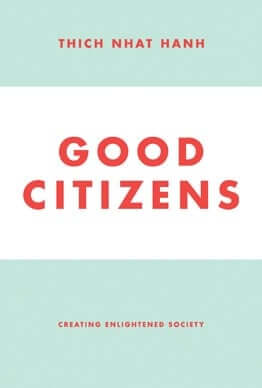
Good Citizens
Creating Enlightened Society
By Thich Nhat Hanh
Parallax Press, 2012
Softcover, 129 pages
Reviewed by Karen Hilsberg and Alex Cline
At the age of eighty-six, our teacher Thich Nhat Hanh continues to actively teach around the world and to publish several new books each year. His latest offering,

Good Citizens
Creating Enlightened Society
By Thich Nhat Hanh
Parallax Press, 2012
Softcover, 129 pages
Reviewed by Karen Hilsberg and Alex Cline
At the age of eighty-six, our teacher Thich Nhat Hanh continues to actively teach around the world and to publish several new books each year. His latest offering, Good Citizens, is profound. Deliberately published before the 2012 elections in the United States, this handbook offers guidance to take the practice of mindfulness and the reality of interbeing to a global level. Without being dogmatic or philosophical, Thay clearly explains how individuals can live an ethical way of life that will contribute to personal and societal well-being. This book is targeted to a broad audience and is sure to have very wide appeal.
Thay’s teaching works equally well for non-Buddhists and Buddhists. This book is a wonderful introductory text that clearly explains the practice, the logic, and the relevance of mindfulness in plain English. Thay presents the Buddha’s teachings of the Four Noble Truths and the Noble Eightfold Path in a manner that is clear and relevant to our modern lives. He spells out how we can live our lives in order to contribute to an enlightened and peaceful society.
For readers who are familiar with Thay’s teachings, this book presents the essential elements of Buddhist practice in fresh and inspiring ways that are applicable to our daily lives. Thay shares meaningful and thought-provoking reflections on historical events in the context of a new global ethic. He offers insights into President Obama’s speech at Cairo University in 2009 and the dropping of the atom bomb on Hiroshima and Nagasaki. His pithy commentary on the Five Mindfulness Trainings toward the end of the book is breathtaking in its lucidity and relevance.
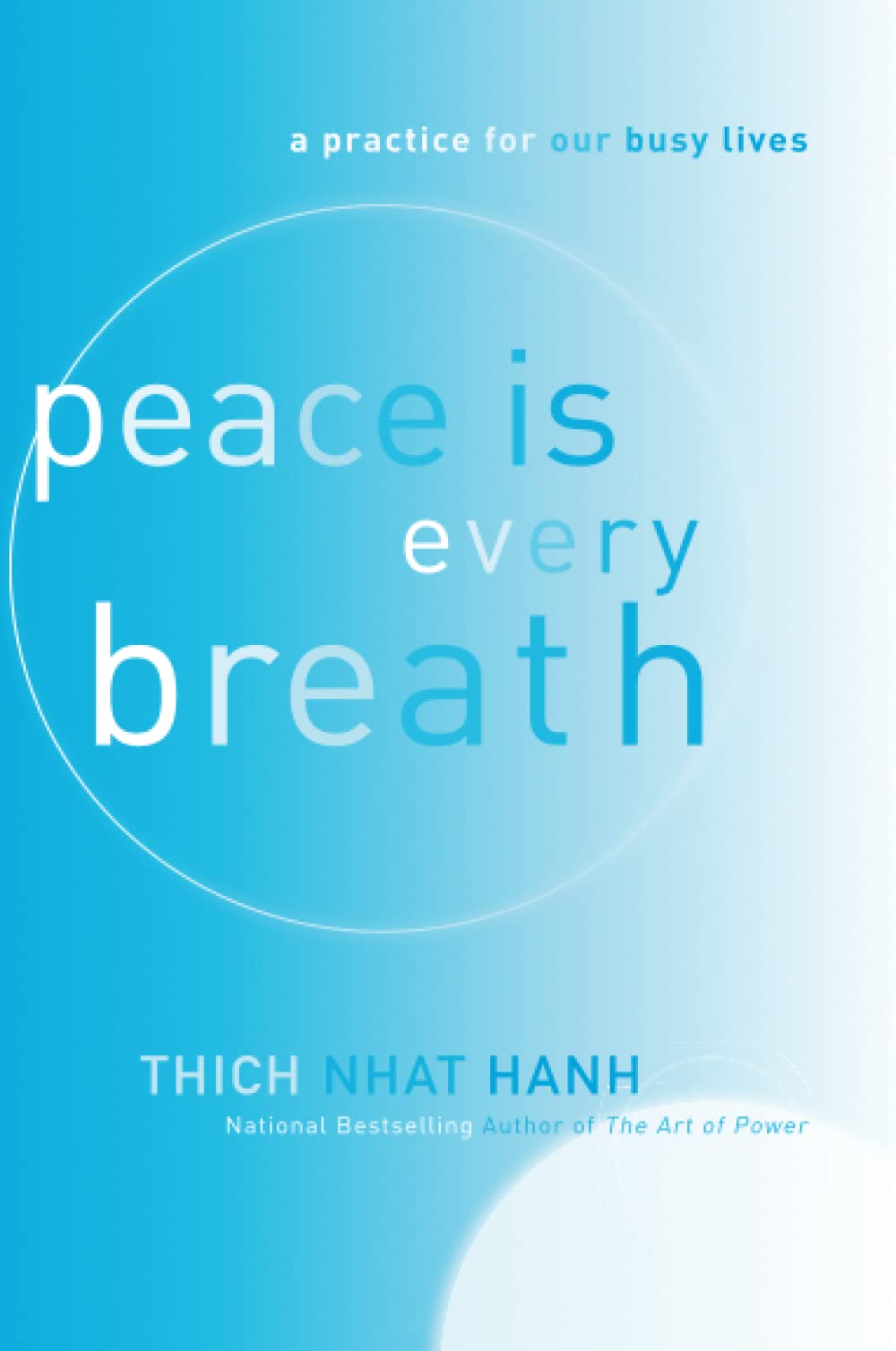
Peace is Every Breath
A Practice for Our Busy Lives
By Thich Nhat Hanh
HarperOne, 2012
Hardcover, 147 pages
Softcover, 147 pages
Reviewed by Judith Toy, True Door of Peace
Under one cover, in one small primer, are Thich Nhat Hanh’s most poignant teachings, peppered with his charming calligraphy. Out of his great compassion for all beings, our teacher addresses the difficulties and suffering of modern society by offering us clear, concrete practices to transform pain and agitation into joy and serenity. “Allow this book to be your companion,” he writes in the Author’s Note. Designed to encourage us in the development of mindfulness and concentration, “the core energies of spiritual practice,” this handbook for living has the potential to lead to a deepening spiritual practice for all of us.
To introduce the wondrous practices of this book, Thay offers a sketch of his typical reader, describing all of us: “You have lots of work to do, and you like doing it. It’s interesting, and you enjoy being productive. But working too much, taking care of so many things, tires you out. You want to practice meditation, so you can be more relaxed and have more peace, happiness, and joy in your life. But you don’t have the time for daily meditation practice. It’s a dilemma—what can you do? This book is your answer.”
I keep Peace Is Every Breath by my bed. As I need them, I can turn to sections such as “Loving Speech,” “Boundless Love,” and “Contemplating No-Self and Emptiness,” and fall into a calm and quiet sleep. I cannot be reminded often enough to take care of my emotions, and that I need not be caught in pain. I can walk in such a way that each step is a miracle. In this small book are as many ways to wake up as we shall need for a lifetime—to touch enlightenment from moment to moment, even in our very busy and very ordinary lives.
All those on our Christmas list will receive a copy of this book in 2012, the most thoughtful gift for any loved one. It is our sincere hope that Peace Is Every Breath will be translated into every earthly language. And then we shall send it to the stars.
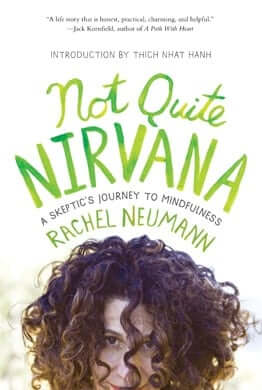
Not Quite Nirvana
A Skeptic’s Journey to Mindfulness
By Rachel Neumann
Parallax Press, 2012 Softcover, 182 pages
Reviewed by Judith Toy, True Door of Peace
With great humor and a talent for anecdote, Rachel Neumann has compiled honest and homespun autobiographical essays, with snippets from her unusual childhood, on how she tripped into mindfulness practice by landing the job as full-time editor at Parallax Press.*
Raised on a “rural commune, surrounded by trees, goats, water, and a roving gang of other dirty, half-naked children,” the child of a father named Osha who works with the homeless, Neumann as we meet her is a self-proclaimed “outsider” and a skeptic. With daughters named Luna and Plum, and their father, she navigates the complicated waters of family life. She edits books about the Dharma with a babe in arms, learning to simultaneously nurse her baby and type. She admits that sometimes “the current moment is just in the way.” Yet it is clear that she learns as she goes.
Neumann, prompted by her early years on the commune, makes of her Bay Area home an international community center. She rents out a room to those who show up and gathers her neighbors for nettle tea and meals. One has the sense that her life is one happy accident after another—all of which she makes the most of.
Neumann is everywoman. We can all identify with her foiled attempts at mindfulness and compassion, as well as with her moments of true awareness. She begins one wonderful story like this: “I am walking to my office to work on a book about how interconnected everyone is and how we all need each other, when a man starts yelling at me out his car window.”
Neumann’s credits are amazing. She has worked as an editor with His Holiness the Dalai Lama, Sylvia Boorstein, Sulak Sivaraksa, and for the past ten years as primary editor for Thay. She has written for Shambhala Sun, Village Voice, and The Nation. But reading her book, you would never know of her resume; you’d only know the truth of her everyday life with those who happen by. To get a sense of her storytelling abilities, visit Neumann’s blog at www.peaceandsleep.org.
* Parallax Press publishes the majority of Thay’s books in English.
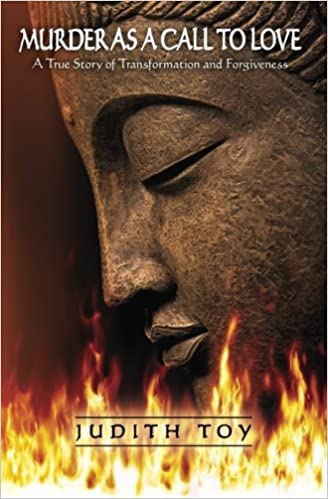
Murder as a Call to Love
A True Story of Transformation and Forgiveness
By Judith Toy
Cloud Cottage Editions, 2012
Softcover, 263 pages
Reviewed by Beth DeLap, Compassionate Path of the Heart
Judith Toy’s book, Murder as a Call to Love, will leave you forever moved and inspired. Her story is one of grace, courage, and diligence in the face of unspeakable loss. She does not portray herself as a super-human saint who is here to tell us what to do when someone we love has been murdered. She takes us with her. You’ll be amazed when you arrive, with Toy, at an unlikely and seemingly impossible teaching: forgiveness. This is a forgiveness for ourselves and for others. It is not stuck, like anger—it flows, like love.
Woven throughout are the teachings of Thich Nhat Hanh. Like gems in a tapestry, his words are placed in the story just as the author found them. We hear how she set out to apply them. As her story deepens and unfolds, Thay’s teachings on interbeing deepen and enfold into our hearts, his words taking on the nature of street signs that we notice at first, then begin to internalize. In our walk with Judith we discover the Five Mindfulness Trainings. We turn another page and there are the Eight Realizations of the Great Beings. Rounding a corner we find this reminder: “The Buddha gave us very effective instruments to put out the fire in us.” Thay patiently repeats his message of interbeing until we discover, along with Toy, that there is a powerful path to peace that is available to all.
There are personal letters from abuser to victim, from victim to abuser. An appendix provides resources for those interested in the forgiveness path. I found much that I could relate to, much food for thought, and such an insistence on love that I remain captivated even now, after closing the book.
Toy has unwrapped, examined, suffered, and loved her way through to a personal peace that has the power to heal many. With her lovely word-crafting and talented storytelling, the author pulls us into what may be a lifelong practice of forgiveness. This book will benefit all beings as we continue our collective journey to peace.
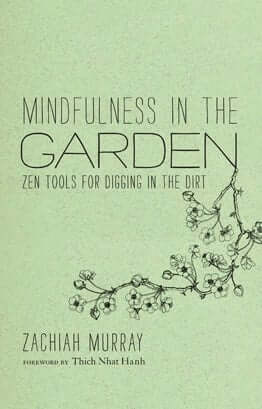
Mindfulness in the Garden
Zen Tools for Digging in the Dirt
By Zachiah Murray
Parallax Press, 2012
Hardcover, 151 pages
Reviewed by T. Ambrose Desmond
Tending a garden is one of the core images used in teaching the path of mindfulness. We are taught to see our mind as a garden that needs tending, and we are taught how to play the role of gardener. Thay often speaks about his love of growing vegetables and how great a teacher a garden can be.
In Mindfulness in the Garden, Zachiah Murray invites us to fully experience all of the teachings that our gardens are trying to give us. The book includes a foreword by Thay and is structured around a collection of lovely new gathas that invite us to bring our practice into every aspect of gardening. From entering the garden to working with weeds to the harvest, we are guided to see the realities of impermanence and interbeing shining through our experience in the garden.
One of my favorite gathas in the book is the one for practicing with seeds that do not sprout:
Sometimes even with mindfulness,
my garden fails to thrive.
With breath, mind and hands free,
the seed of my equanimity emerges.
In her commentary, Zachiah reminds us that our practice is most strengthened when we are challenged. She calls these challenges “good medicine” and encourages us to see them as opportunities for learning and growth. With a calm and soothing voice, she helps us to let go of our attachments to outcome and arrive in the beautiful present.
Transforming our garden into both a meditation hall and a living sutra, the gathas contained in Mindfulness in the Garden help us to bring a sense of wonder and depth to our relationship with the natural world.


